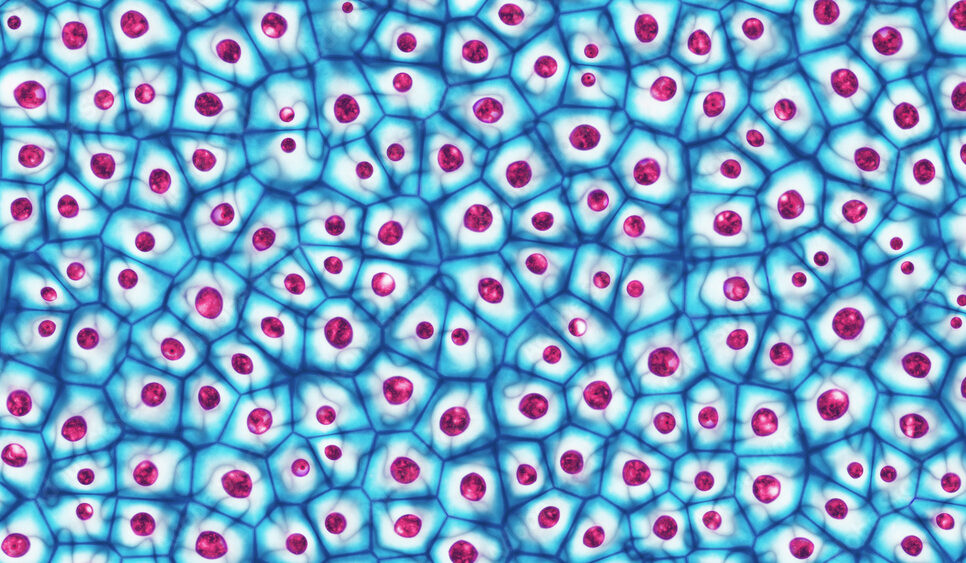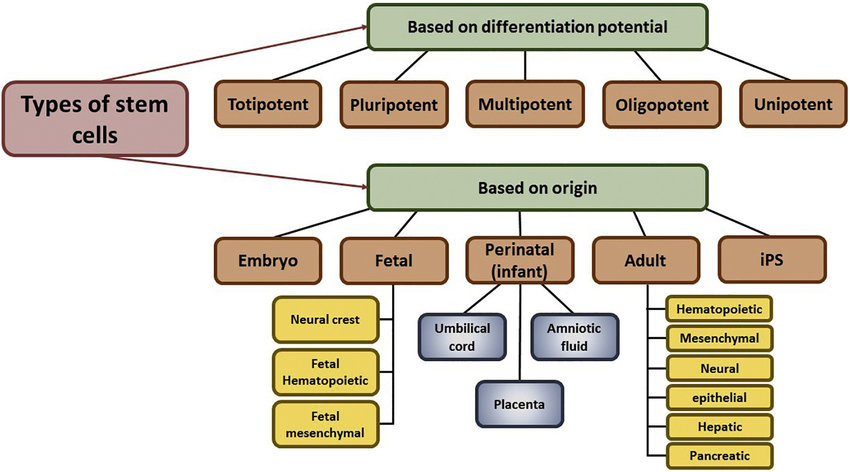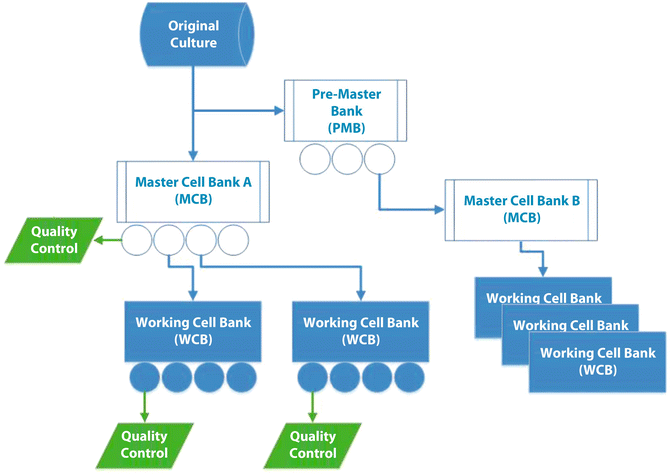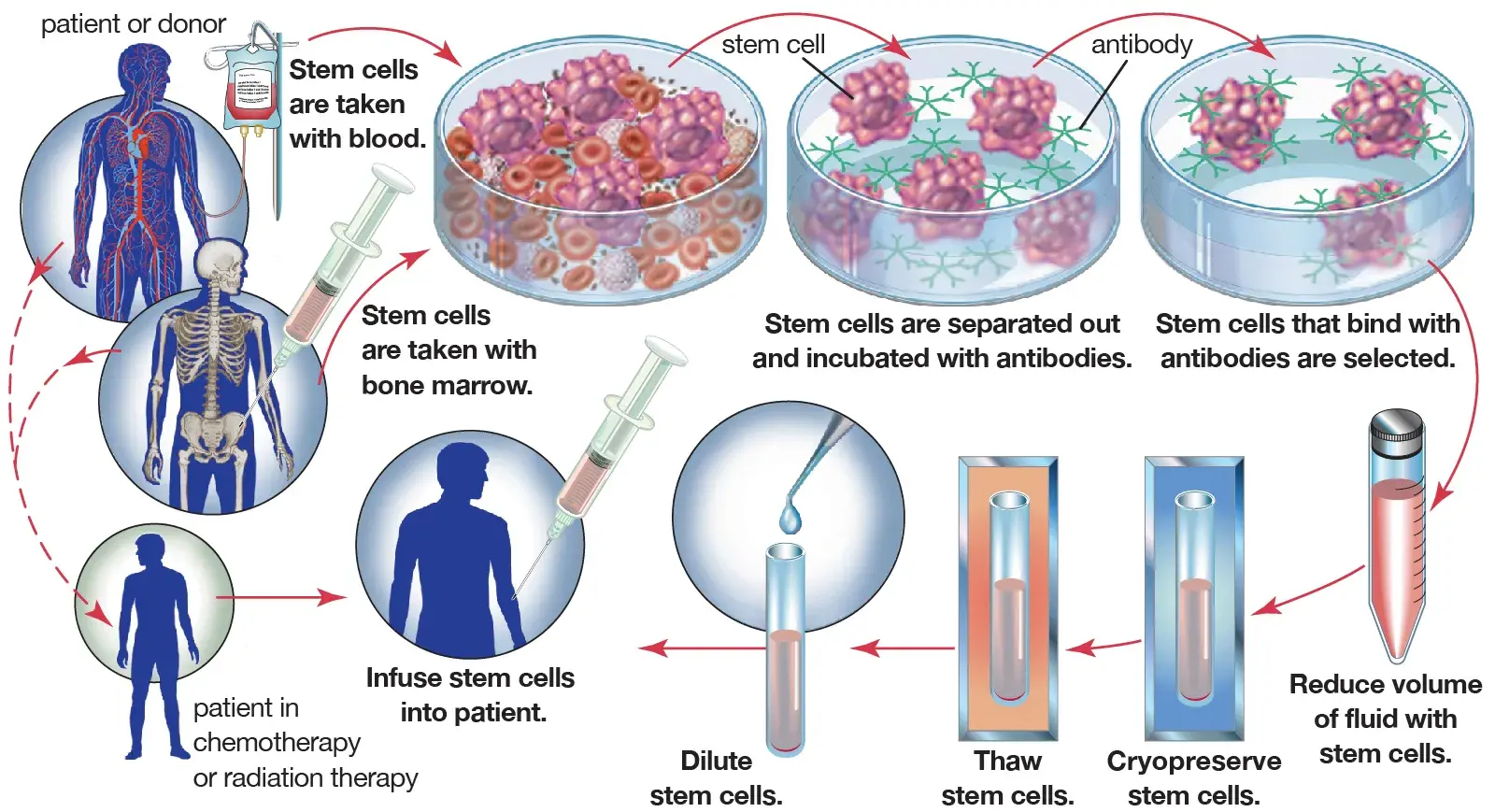Introduction to Stem Cells
Stem cells are unspecialized cells capable of renewing themselves through cell division, sometimes after long periods of inactivity. Under certain physiologic or experimental conditions, they can be induced to become tissue- or organ-specific cells with special functions, according to the National Institute of Health.
There are three main types of stem cells:
- Embryonic Stem Cells (ESCs): These are derived from embryos. Most embryonic stem cells are derived from embryos that develop from eggs that have been fertilized in vitro.
- Adult Stem Cells: Also known as somatic stem cells, are found in small numbers in most adult tissues, such as bone marrow or fat.
- Induced Pluripotent Stem Cells (iPSCs): These are adult cells that have been genetically reprogrammed to an embryonic stem cell-like state.

Stem cells are unique due to two important characteristics. Firstly, they have the remarkable potential to develop into many different cell types in the body during early life and growth. Secondly, in many tissues, they serve as a sort of internal repair system, dividing essentially without limit to replenish other cells.
The Biological Function of Stem Cells in the Body
Among the myriad of cells that constitute our bodies, stem cells stand apart. These unique cells possess two key characteristics that make them indispensable. Firstly, they can self-renew and create more of the same kind of cells. Secondly, they can differentiate into specialized cells under certain physiological or experimental conditions.

Differentiation of Stem Cells Into Various Cell Types
Stem cells are like the body’s raw material, from which all other cells with specialized functions are generated. They can be directed to become specific cells, like a heart muscle cell, brain cell, or blood cell, through a process called differentiation. This transformative ability is the basis for the potential uses of stem cells in medical treatments and research.
The Role of Stem Cells in Development, Growth, and Repair
Stem cells play a critical role in the body’s growth, development, and repair. They contribute to the body’s ability to renew and repair its tissues. In the human embryo, stem cells differentiate into all the specialized cells that form the organs and systems. In adult tissues, such as bone marrow, muscle, and brain, discrete populations of adult stem cells generate replacements for cells that are lost through normal wear and tear, injury, or disease. This makes stem cells valuable for healing and regenerative medicine.

Understanding Stem Cell Therapy
Stem cell therapy, often referred to as regenerative medicine, promotes the reparative response of diseased, dysfunctional, or injured tissue using stem cells. These are unprogrammed cells capable of developing into various cell types. They are guided to become specific cells that can be used to regenerate and repair diseased or damaged tissues in patients.
With the ability to replace or repair tissue, stem cell therapy has the potential to treat a range of diseases and conditions. This includes Parkinson’s disease, spinal cord injuries, burns, heart disease, diabetes, and arthritis, among others.
Potential Benefits and Risks of Stem Cell Therapy
While stem cell therapy carries immense promise, it also comes with potential risks. The benefits include the ability to speed up healing, reduce pain and inflammation, and potentially avoid surgical intervention. However, risks include adverse reactions, infection, failure to work as expected, and the possibility of the cells changing into unwanted types.

To continue enhancing your understanding of stem cell therapy, reviewing a diagram showing the process from extraction to injection could be beneficial. This would visually demonstrate the steps involved in this complex therapy.
Stem Cell Sourcing and Harvesting
Stem cells used in therapy are typically sourced from three primary areas: adult tissues, embryos, and umbilical cord blood. Adult stem cells can be extracted from various tissues, including bone marrow and adipose tissue. However, they are generally present in small quantities and have a limited capacity for division. Embryonic stem cells, on the other hand, are derived from unused embryos from in-vitro fertilization procedures. They have significant therapeutic potential due to their ability to differentiate into any cell type.

Stem cell extraction involves a process known as harvesting. For adult stem cells, this typically involves a procedure similar to a blood transfusion, while embryonic stem cells are extracted from the inner cell mass of blastocysts.
Ethics of Stem Cell Sourcing
The use of embryonic stem cells, despite their therapeutic potential, is embroiled in ethical controversy. The primary concern revolves around the destruction of embryos, which some argue is akin to terminating potential human life. As such, the National Institute of Health has strict guidelines regulating the use of embryonic stem cells in research and therapy.
Processing and Differentiation of Stem Cells
Stem cell therapy holds great promise in the field of regenerative medicine. The process begins with the harvesting of stem cells from an appropriate source such as bone marrow, adipose tissue, or umbilical cord blood. These cells are then processed in a laboratory setting.
Processing involves isolating the stem cells from the harvested tissue, followed by their expansion in culture. This is a critical step, as it ensures a sufficient number of cells for therapeutic use.
Once the cells are expanded, they are induced to differentiate into the desired cell types. This induction is achieved by exposing the cells to certain biochemical cues, capable of guiding their fate.
Quality Control in Stem Cell Processing
Quality control measures are meticulously put in place to ensure the purity and safety of the stem cells. These measures include testing for contamination, verifying the identity and potency of the cells, and confirming their stability and viability.
Certified laboratories adhere to FDA guidelines for processing stem cells, which further ensures their safety and efficacy.

The Actual Therapy: Implantation and Integration
The actual stem cell therapy involves the reintroduction of the stem cells back into the patient’s body. This process, also known as implantation, is typically done through injections or intravenous infusion. The goal is to introduce these cells into the damaged area, where they will start their work.

Once implanted, the stem cells begin the process of integration. They naturally migrate to the damaged tissues, where they start to repair or replace the cells. This unique characteristic of stem cells makes them an invaluable tool in regenerative medicine.

Monitoring and Follow-up After Therapy
Post-therapy, it is crucial to monitor the patient’s progress. This includes regular check-ups to assess the efficacy of the treatment and to monitor for potential side effects. Rigorous follow-up ensures the optimal outcome and patient safety during the recovery process.
Notable Success Stories in Stem Cell Therapy
In the realm of stem cell therapy, various case studies have shown promising outcomes. For instance, a study by Stanford University School of Medicine demonstrated that stem cells could restore sight in patients with age-related macular degeneration. Similarly, stem cell therapy has shown potential in treating spinal cord injuries, as evidenced in a case study by the Mayo Clinic.
 .
.
Current Research and Clinical Trials in Stem Cell Therapy
Presently, numerous clinical trials are underway, exploring the efficacy of stem cell therapy in treating conditions ranging from heart diseases to Alzheimer’s. For instance, the National Institute of Health is conducting a trial on stem cell therapy for Parkinson’s disease.
Future Potential of Stem Cell Therapy
Looking ahead, stem cell therapy holds significant potential in treating various diseases and conditions. By harnessing the regenerative capabilities of stem cells, researchers aim to develop treatments for conditions such as diabetes and arthritis.

Conclusion: Envisioning the Future of Stem Cell Therapy
Stem cell therapy, currently, is still in its nascent stages, yet it holds enormous potential for treating a wide spectrum of diseases, from cancer to neurodegenerative disorders (National Institute of Health). However, this revolutionary therapy is not without its risks, including possible immune system reactions and the unforeseen consequences of cell behavior.
Despite these risks, the ongoing research in the field is promising, indicating a future where stem cell therapy could be a standard treatment option. However, reaching this future will not come without significant challenges along the way.
Considerations regarding the ethical procurement of stem cells, the necessary regulatory oversight to ensure safety and efficacy, and the practical aspects of delivering these therapies to patients worldwide are all hurdles that need to be navigated successfully.
Nonetheless, the future of stem cell therapy is bright, promising a new frontier in medicine that could potentially change the way we approach treatment and healing.
